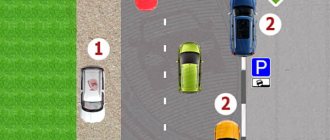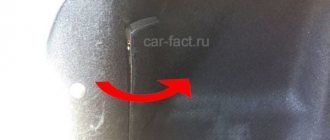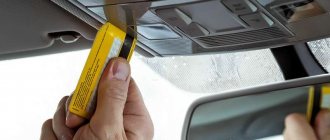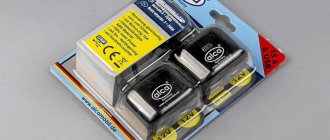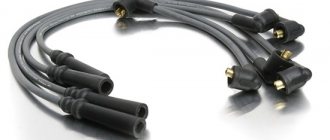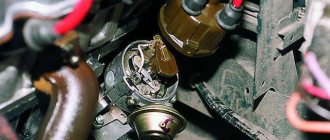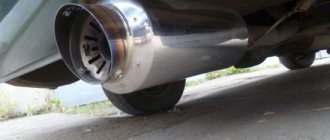Faced with a completely discharged battery somewhere along the way, the car owner finds himself in a difficult situation. You either have to look for a donor car to light a cigarette by connecting the car starter to a third-party power source. An important point: in the trunk you must have special thick cables equipped with clamps. It is not necessary to purchase them - make reliable wires for lighting your own using the instructions below.
Foto 2a
There are quite a few “lighting” wires on sale, but most of them quickly disappoint. The reason is simple - saving copper to the point of absurdity. Having decided to close this issue, I bought six meters of KG‑10 cable (it is flexible, the cross-section of the copper core is 10 mm²). At the same time - four welding “crocodiles” for a current of 200 A, and for sealing the ends of the cable in them - four copper-plated tips.
Having cut the cable in half, I assembled everything, and connected the halves of the cigarette lighter with clamps offset by 300 mm, so that when connected to the battery, the free “crocodiles” would not short-circuit. Finally, I used blue and red electrical tape to mark the “plus” and “minus”. The homemade kit cost no more than dubious “branded” wires. It does not heat up even when starting the KamAZ truck and has helped me and my friends out more than once.
Do-it-yourself electrics: Making high-quality wires for lighting a car
Introduction
Good afternoon, dear readers.
In this article we will talk about how to make such wires for lighting yourself so that you can start a car with a completely dead battery. This can happen if you leave for a long time and forget to turn off the light. Or in severe frosts. This is exactly what happened in central Russia a couple of weeks ago - when the temperature suddenly dropped to -27 and many were unable to start, including my neighbor. For this reason, at his request, I made him wires for lighting, which will be discussed in the article.
(Picture taken from the website liveinternet.ru) For residents of Siberia and the northern regions of Russia, frosts are commonplace and, usually, their cars are well prepared for winter (see the last section of the article). But for residents of the middle zone, especially those living in large cities, unexpected frost can pose a serious problem.
Why not “buy ready-made wires”? The thing is that there are simply no quality ones on sale. Of all the ones I saw, there was something more or less decent in the review of the magazine “Behind the Wheel” and was called “advice from an auto electrician.” But this product was specially made by the manufacturer for the test of this magazine - so there are doubts that standard products have the same workmanship.
Why isn't it on sale? The fact is that a high-quality cigarette lighter, taking into account the multiple market markups, will cost the buyer such an amount that simply no one will buy it.
Therefore, the shelves of car dealerships are filled with expensive and at the same time low-quality junk, mainly Chinese (but also Russian) made. The packages say currents of 500, 600 and even 1000 amperes, but these are all “Chinese” amperes and must be divided by at least 10.
Of course, these cigarette lighters help, but only if the battery is only slightly discharged. Or if charging takes a long time (at least 6-10 hours). But is anyone ready to light your car for such a long time? Usually, if the car does not start within 20-30 minutes, the owner locks the car and takes the bus.
What is a high-quality cigarette lighter and why is it needed?
I previously wrote about Chinese and Russian cigarette lighters and wrote that, unfortunately, almost always, they are of poor quality.
Even the cigarette lighter from the famous American brand Snap-On, costing 12 thousand rubles (as of January 2022), according to test results, turned out to be of poor quality (which is doubly offensive considering such a high price).
Here is the review from Za Rulem magazine based on the test results:
The biggest disappointment of the test. A big name and a deafening price are all that the product is remembered for. A soft, frost-resistant wire is good, but even at a modest current of 480 A, the voltage drop exceeded 2.0 V.
What is a high-quality cigarette lighter?
A high-quality cigarette lighter is a cigarette lighter that, due to its design, is capable of passing the rated current of the starter of the acceptor car with a minimum voltage drop (less than 1V) in a time sufficient to start the engine of the acceptor car (this time is considered equal to 30 seconds). Next I will write “donor” - the one who gives a light, “acceptor” - who is given a light.
The quality of a cigarette lighter is determined by the following components:
- Wire, namely core and insulation.
- Alligator clips
- Connections
All three components are subject to strict requirements due to this?
that the cigarette lighter must pass large starter currents, as well as maintain insulation flexibility at low temperatures. For example, PVC insulation hardens in the cold and cracks when the wire is bent. Therefore, rubber or silicone insulation is used for cigarette lighter wires. But many manufacturers, in order to save money, make PVC insulation with the addition of additional plasticizers. As a result, at -30, the insulation on the wires cracks and using such a cigarette lighter is simply dangerous (despite the low voltage of 12 volts, shorting the battery positive to the car body through a crack in the insulation will lead to dire consequences).
A passenger car battery has a nominal voltage of 12 volts, and the starter motor in an average passenger car has a capacity comparable to that of a cooktop. For example, about 7 kilowatts (approximately this power is required to crank the crankshaft of a two-liter engine). From here, through simple calculations, we obtain the rated starter current equal to 7000/12 = 583 amperes. In fact, the voltage on a charged battery is more than 12V (usually 12.7), therefore, the current is less, but this is not so important - it is important to understand where such huge currents come from.
(Diagram of a car starter. Picture taken from the site transtarter-spb.ru)
This is the current the battery must produce in order for the engine to start. This current is indicated on the battery itself as cold cranking current. And if the battery is severely discharged, then in order to start the engine, such current must be withstood not only by the cigarette lighter cable, but also by the alligator clips, all transit connections in the cigarette lighter, connections to car batteries, etc.
If there is a weak link somewhere, the voltage will drop due to its resistance, and the connection itself will get very hot. As a result, if the battery is dead, the acceptor engine will not be able to start.
It is also obvious that the cross-section of the wire must be copper, have a sufficiently large cross-section and at the same time be as short as possible (but so short that it is possible to reach from the battery terminals of one car to the terminals of another - therefore such wires are usually not made shorter than 2.5 meters). Crocodiles must have powerful clamps with a large contact area, and the connections must be reliable and have low contact resistance.
How are typical cigarette lighter wires arranged? commercially available?
Let's look at a typical cigarette lighter costing from 500 to 1500 rubles with a stated rated current of 400-600-1000 amperes. They almost all look like this:
(Photo taken from dvizhok.su)
Such cigarette lighters consist of tin crocodiles with copper coating, as well as wires with a cross-section of 2.5 to 4 squares (it all depends on the generosity of both Uncle Liao and the Russian seller who ordered this wire from the Chinese). At the same time, the wires have abnormally thick insulation - obviously, this is done with the aim of deceiving the buyer (an attempt to show that the cross-section is actually larger than it is). The insulation usually consists of PVC with a high content of plasticizers. The wires are attached to the crocodiles by pressing with brackets covered with insulated handles.
Naturally, there can be no talk of any current of 600 amperes (or even 100!). Such cigarette lighters are only suitable for lighting batteries that are not very low. Or it is necessary to charge the battery of the acceptor vehicle for a long time (for many hours) with low currents.
Let's take a closer look:
The crocodile design does not inspire confidence - everything hangs loose. The “crocodiles” themselves are made of copper-plated sheet metal with a very small contact area (in fact, the “crocodile” is in contact with the battery terminal only with the thin side surface of one clamp).
The copper strands of the wire are pressed against the surface of the “crocodile” in a bundle (as in the photo below). At the same time, the wire itself is protected from insulation. they press the staples inside the crocodile handle (unfortunately, I didn’t take a photo of the fastening, but take my word for it - it’s just terrible). Due to poor quality wire, the cores and insulation are easily frayed, as can be seen in the photo:
Now let's look at the negative wire in cross-section. Nearby, for comparison, is a PuGV wire with a cross-section of only 10 mm2, which is used for assembling apartment panels with currents of up to 63 amperes. Absolutely most of the Chinese wire is occupied by hypertrophied insulation, and the cross-section of copper is approximately 2.5-3 square.
Is it worth throwing money at such junk? After all, it is obvious that such a design will not withstand even a current of 100 amperes (or even 50!).
Such cigarette lighters are only suitable for “lighting up” slightly dead batteries.
Selection of components for cigarette lighter wires.
You should first start by understanding what current rating it should be rated for.
This information is written on the battery itself (cold start current). Let's take as an example the current of one starter - 530 amperes. Accordingly, all components are selected for a given current. Due to the very limited range of devices offered on the Russian market, it is sometimes necessary to take components designed for a slightly lower current. But with a competent approach, there is nothing to worry about.
Clamps produced by the Italian company AE with a rated current of 500 amperes were chosen as “crocodiles”. The crocodiles are made of solid brass and have a contact area corresponding to the current. Each of the handles has a hole for an M4 screw for attaching a wire; one of the holes comes with a thread. There is a red and black option.
These “crocodiles” were ordered from the online store 12vi.ru. If you have a large black SUV or are the happy owner of a truck or truck, this store has several options for “crocodiles” with a rated current of up to 850 amperes.
Next you need to select the wire. There are several options, including with silicone insulation (operation at temperatures up to -60). But such temperatures do not occur in the central part of Russia, so a cheaper (and most importantly - available at Elektromontazh for cutting) flexible cable for welding machines with rubber insulation was chosen - KG / KOG1 in the U production version, from my point of view, the best cable plant among Russian ones - Kolchugino. Operating temperature is up to -40 degrees, which is more than enough for this region. For perfectionists or residents of Siberia/northern regions, it makes sense to choose a HL cable or a wire with silicone insulation.
The cable cross-section is chosen to be 35 mm2. It was also necessary to solve the following two problems - the 35 square cable is very thick, it cannot be attached directly to these “crocodiles”. In addition, a high-quality connection of the “crocodile” with the battery terminal can only be ensured if voltage is applied simultaneously to both sides of the clamp, and not to just one, as is done on all cigarette lighters I have seen.
For these purposes, the KOG1 1×16 cable, also produced by Kolchugino, was chosen. It is more flexible than the KG, and in addition it will allow you to connect the main wire to the crocodiles (16 squares of copper will fit to each half of one “crocodile”).
Total: 4 meters KG 1×35, 2 meters KOG 1×16, All cable was purchased at the Electrical Installation store. Additional parts were also purchased there for the manufacture of cigarette lighter wires - 4 GML sleeves for 35 mm2, 8 TML type tips for 16 squares for an M8 screw, as well as M8 screws with full threads as short as possible. I bought Italian tips of the TML type, manufactured by VM - since the KVT assortment does not have tips that would be short enough and would fit in width. If you buy tips, be sure to check that they will fit - these “crocodiles” have sides at the edges!
All the goodness in one photo. An adhesive heat shrink of two sections will also be used, but I did not buy it since I have it in stock. Unfortunately, if you have to buy it “from scratch”, it will be very expensive - this is especially true for heat shrinkage to protect GML, very little is required, and it is sold in at least a meter piece. As an option to save money, do not insulate the wire coming from the TML tips with heat shrink, but insulate the GML sleeves with cotton insulating tape and fix it with glue.
I had great doubts about the correctness of purchasing tinned parts (namely GML and TML). Since tin at low temperatures is at risk of “infection” with tin plague. But on the other hand, on the Internet I found the operating temperature of TML up to -70, and in any car there are a lot of soldered parts and somehow it all doesn’t fall apart, and satellites fly into space with a bunch of soldered joints.
By the way, here are the sections of KOG1 1×16 and KG 1×35 for comparison with Chinese products:
Assembling wires for the cigarette lighter
"Crocodiles" have factory holes for M4 screws, but this is no good! The holes are drilled out with a drill, then threads are cut into them using an M8 scriber. The hole, accordingly, must be drilled a millimeter narrower, that is, with a 7 mm drill.
Next, take the TML tip and screw it to the crocodile with an M8 screw, after which the excess screw is cut off with a hacksaw. This is necessary in order to accurately measure the length of the screw:
As a result, all screws are shortened. Unfortunately, I didn’t find such short screws on sale, so I had to farm:
“Crocodiles” with handles removed and short screws installed:
Next, the KOG1 cable is cut into 8 equal parts (25 cm each) and stripped. The length of the “pigtail” should be such that it fits into the TML screwed to the hole with a screw, and the insulation begins immediately where the plastic of the handles ends. You cannot leave the insulation on - it is too thick, the cable will not fit into the gap of the crocodile handle, and in this case, the plastic insulation of the handles will not fit.
Next, TML tips are crimped onto the “pigtails”. This is done using PK-35 press jaws from KVT.
Of course, it would be better to press not with a point, but with a hexagon using hydraulics, however, due to the nature of my work, I do not work with large sections and do not have hydraulic press tongs. However, point crimping also ensures excellent contact.
Next, adhesive heat shrink is applied and shrinked with a hairdryer. If you want to save money, you can skip this step, but it’s still better to do:
Next, it is all fixed in this way:
And the insulation of the handles is put on. If everything is done correctly, there is no need to cut holes in the insulation:
After which the main connection is made using GML sleeves. In order for two 16-square cores to fit properly, on one side the sleeve is slightly clamped with pliers.
It is crimped with the same PK-35. I was even surprised how easy it is to do this for a section like this:
After which the sleeve and sections of wire on both sides are insulated with adhesive heat shrink. This is what happened (negative wire). The total length is 2.5 meters (and if you count from the “nose” of the “crocodiles”, then even a little more):
The second wire (positive) is made in the same way:
And that's what happened;
The wires for the cigarette lighter turned out to be very heavy, but reliable. From periodic maintenance - only tightening the bolts.
I also decided to make additional protection against overcurrents (in case of an erroneous connection or short circuit) - unlike the Chinese, such a cable will not burn out in the event of a short circuit, but it’s better not to think about what will happen to the battery. For these purposes, Polish fuses with a nominal value of 500 amperes were purchased, as well as TML tips with a cross-section of 35 squares:
The fuses are inserted into the middle of each wire onto a bolted connection using an M8 screw and are insulated with heat shrink. But there was no time to finish it yet, and besides, there are no manuals anywhere about what the time-current characteristic of these fuses is and what voltage drops across them at the rated current. I decided to wait for now.
How to avoid or minimize the use of cigarette lighter wires?
In order for the car to start in the cold in the middle zone, you must follow three rules: have a not very old and charged battery (the higher the battery charge, the better it tolerates frost) with clean terminals and pads (oxidation leads to a strong voltage drop), into the engine “winter” less viscous oil must be filled in, the spark plugs must be “fresh” (if their service life is coming to an end, it is better to replace them).
To do this, the battery should be recharged before winter from a 230-volt network using a special battery charger. The fact is that, given the realities of modern cars and cities, the generator current after subtracting the consumption of all consumers (headlights, air conditioning, fan, on-board electronics, etc.) may be insufficient to fully charge the battery during the trip.
Naturally, for residents of, for example, Norilsk with their frosts, this will not be enough - as far as I know, there, or in winter in general, they take the battery into the heat at night or use a special alarm system that starts the engine several times during the night to warm up.
Important! If you make similar wires for yourself and use them, remember that when , the “donor” motor must be turned off! And, before you spend at least 15-20 minutes using the cigarette lighter wires, you need to recharge its battery (the “donor” motor must be running).
I hope the article was interesting.
Regards, Alexey.
\|/
Foto 3
On the old Opel Astra station wagon, the license plate lights have become unusable. You can, of course, order branded ones - but why? They are so simple that they can be replaced with any that are suitable in size and do not spoil the appearance of the car. I bought lights from a VAZ-2110. They fit perfectly on the German hardware, there were no problems with connection. They shine no worse than the original ones and, I hope, will be even more reliable: the design is closed, protected from dust and moisture. Fasteners - with ordinary self-tapping screws with wide heads.
AND NOT A SINGLE MINUS!
N. GALIMOV, Kemerovo region
Safety precautions when lighting a car
When lighting one car from another, it is important to observe safety precautions, because when the engine starts, there is a possibility of a spark occurring on the “negative” wire, and if the polarity is not observed, the electronics may fail.
Safety regulations:
- Light up cars outdoors or in a well-ventilated area.
- When starting the engine of the recipient car, the engine of the donor car must be turned off. When starting from a running car, the electronics in both cars can burn out.
- Observe polarity when connecting, otherwise a short circuit will occur, which may cause the wire insulation to catch fire.
- Therefore, keep a fire extinguisher ready.
Foto 4
After another antifreeze leak occurred on the VAZ-2114, it occurred to me to install a nipple from a tubeless tire in the expansion tank. Now, using a pump or compressor with a pressure gauge, it is easy to check the integrity of the cover: is it sealed at operating pressures. Let me remind you that the permissible excess pressure in the system is 0.9...1.1 MPa. Next, by placing a blind lid, it is not difficult to find places where liquid leaks. Finally, draining the coolant is simplified: you lower the throttle heating pipe into a bucket and turn on the compressor!
AND THE HEDGEHOG IS IN THE MIST...
M. POLYAKOV, Uglich
On our roads, stones flying out from under the wheels are a common occurrence; You can only consider yourself protected from such shelling in an underground parking lot. Headlights, as is known from the Traffic Rules, must now be turned on even during the day, but many people use foglights only occasionally, when they are really necessary. The rest of the time it makes sense to cover them. On the 2014 Renault Logan sedan, I use for these purposes easily removable liners cut from foil foam sheets that do not have an adhesive layer. The thickness of each liner is 10 mm, and the diameter is slightly larger than the diameter of the headlight glass. Thanks to this, when inserted into the bumper sockets in front of the fog lamps, they sit securely. At the same time, they are very easy to remove.
TWO PLUGS
S. KIRGIZOV, Moscow region
Car jump starters
Portable jump starters with a battery are popular among drivers, which allow you to do without outside help and start the car yourself. Small but powerful lithium ion batteries have a capacity of 20 and even 30 thousand mAh and are capable of creating a starting current of up to 1000 A.
car jump starter
Light weight from 0.4 to 1 kg, portability and functionality attract the attention of many motorists. Such batteries have a built-in flashlight and can serve as a power bank for mobile devices. They also have their own protection system against:
- short circuit;
- overheating;
- overload.
However, the cost of these starting devices, even inexpensive Chinese models, is comparable to the price of a new car battery, or even 2-3 times higher. And there is no guarantee at all that they will run an engine with a volume of 2 liters or more, especially trucks.
Such starting devices will be useful either to professionals or to owners of various mobile gadgets for recharging. Of course, when purchasing, you need to pay attention to the availability of the necessary adapters.
Photo 1 Kirgizov
When I was about to replace the antifreeze on a 2004 Hyundai Elantra sedan, I encountered a problem: access to the radiator drain plug was hampered by the protection of the engine compartment. As you know, dismantling this “armor” is not always an easy job, and even quite dirty. Meanwhile, you can do without dismantling. Directly below the drain plug I drilled a 10mm diameter hole that allows access to it with a suitable screwdriver. If the upper radiator plug is sealed (this is a condition for the system to be in good working order!), liquid does not flow out of the lower hole. Having inserted one end of a suitable hose into it, I lower the other into the drain container, and then calmly open the top plug. The liquid will drain very carefully, and it will be dry under the car.
Advice from experienced people: making “eternal” wires for the cigarette lighter, fighting antifreeze leaks, protecting foglights
How to light a car correctly
In cold weather, even new batteries are subject to heavy loads and often fail, so the need to light a car may arise at any time, or you may be asked for help. Therefore, you need to know how to light a car correctly, so as not to harm your own or someone else’s car. It is advisable to use a car with an engine of equal or greater displacement as a donor car. But, in principle, you can launch a gazelle from Matis.
Step-by-step instructions on how to light a car:
- We position the cars so that the wires can be connected without tension.
- The donor car should run for 5-10 minutes at 2000-3000 rpm in order for its battery to recharge a little.
- We turn off the donor car and turn off the ignition.
- We turn off all electrical appliances in both cars: headlights, interior lighting, radio, heater, air conditioning, navigator.
- We inspect the battery of a car that does not start: there should be no smell, cracks in the case, or leaks of electrolyte.
- We connect one end of the “positive” wire first to the battery of the donor car (from which we will light the cigarette), the other end to the battery of the recipient car.
- We connect one end of the “negative” wire to the negative of the donor battery, the other end to any metal surface of the car that is free of paint (this could be the engine block). If the car does not have such a place, then we connect the second end of the “negative” wire to the “minus” of the battery of the recipient car.
- It is very important to maintain polarity when connecting wires: one wire must connect two pluses, the other - two minuses. If connected incorrectly, a short circuit will occur, which can damage all electronics of both cars.
- We start the engine of the recipient car. With a normal donor battery and the correct connection of the ignition wires, the car should start without problems. We leave it idling, without turning it off.
- We disconnect the wires in the reverse order: first the negative wire from the recipient, then from the donor; then “plus” from the recipient, then from the donor.
- We say thank you and leave.
portable cigarette lighter for battery Car repair video
Charging smartphones is convenient: insert the cable and the energy transfer begins immediately, no need to press anything. It is not possible to stop the process by accidentally pressing the button; to do this, you need to pull out the wire.
I’m also thinking about buying such a thing - it might come in handy when traveling, because I usually read a lot on the road, and the charge may not be enough for a day. It's great that the gadget is compatible with Samsung! Thanks for the info, I’ve bookmarked it. Xiaomi’s battery line already has a model with a capacity of 5200 mAh based on 18650 size batteries, which were also used in the company’s 10400 and 16000 mAh batteries. However, Xiaomi reasonably decided: if there is a demand for compact batteries, the idea needs to be developed. So another battery of similar capacity appeared - 5000 mAh.
portable cigarette lighter for car battery Car repair video
In terms of design and materials used, the new Xiaomi PowerBank 5000 is no different from other models of the company. The body is made of anodized aluminum, which the company compares to the aluminum Apple uses in MacBooks. The accessory can withstand up to 50 kg of weight. The edges of the body are slightly rounded for ease of grip. In general, the new battery looks very simple and, at the same time, beautiful. Needless to say, Xiaomi has produced another accessory with a good design, albeit reminiscent of Apple products. However, if in the case of smartphones or some other devices (an air purifier, for example) we can talk about almost complete copying, then in the case of “power banks” we see exactly echoes of Apple, and not thoughtless copying. It is noticeable that Xiaomi was inspired by the products of this company. And, by the way, looking ahead, I will say that this is why the new Xiaomi PowerBank is perfect as a gift for owners of Apple smartphones and tablets.
Xiaomi's powerbank will no longer surprise anyone. It feels like almost everyone has already bought them. This is not surprising, because in terms of price/quality ratio, their portable chargers simply have no competitors. And many people need this thing, because the battery charge of mobile phones lasts for most users for a day, and some people are even plug-dependent people. When the game “Pokemon Go” became extremely popular, according to one seller of an electronics store, sales of power banks increased significantly) Constantly playing the game, people began to run out of batteries and they rushed to stores... A whole power bank mania began! But, as it turned out, there are still people in Belarus who have not yet bought a powerbank))) Actually, one of my friends asked to order it in China. Since the regular Xiaomi power bank 10000 mah has already been “reviewed” by everyone who can, I ordered the updated version of Mi Power Bank 2 (2$ more expensive). What are the differences? I have such a gadget, but from a different company. Mine takes half a day to charge from USB to 100% and weighs like a brick. Time to invest in a newer model!
Charging and pre-starting device
An excellent cigarette lighter option for those who have the opportunity to extend a network cable to the car is a household car charger of the Orion or Vympel type. This is an inexpensive option for lighting a cigarette yourself by first reviving a dead battery.
pennant
The essence of the method is to connect the charger to a car battery, set the maximum charging current for 5-30 minutes and start the engine with the connected device.
The pre-start charge revives the battery, and in the first seconds of the starter operation, a large current is created, allowing you to crank even oil that has thickened in the cold on the first try. The manufacturer recommends the multifunctional models “Vympel-30”, “Vympel-325”, “Vympel-40” for these purposes. The cost of the device is about 3000 rubles. Moreover, all universal models are capable of charging and restoring dead batteries.
The nuances of starting the engine from an external source
- It is impossible to drive the required distance to a stalled car. In this case, they make a twist from several sets of starting wires - they hook the “crocodiles” to each other and wrap them with insulating tape. If the car has a carburetor, then replace the discharged battery with a working one, removed from another car, and start the car. Without turning off the engine, return the standard (discharged) battery to its place.
- Before disconnecting the jumper wires from the battery terminals, it is recommended to turn on the fan in the cabin and the heated glass of the donor car. These actions will avoid a voltage surge in the electrical network.
- A car running on gasoline will not be able to start a diesel engine. The reason is the weak starting current of the battery in gasoline cars.
On some brands of cars, due to design features, it is difficult to reach the battery terminals. In this case, a special positive terminal for “lighting” is installed in the engine compartment or inside the car.
Some drivers had the unfortunate experience of “lighting up” from another car. When the battery exploded, plastic fragments of the case and sulfuric acid, which is part of the electrolyte, affected the face and eyes
Following safety precautions will help avoid injury.
